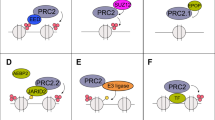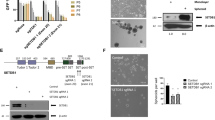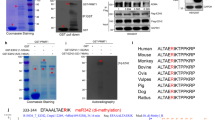Abstract
Enhancer of zeste homolog 2 (EZH2) is a critical component of the polycomb-repressive complex 2 (PRC2), which is involved in gene silencing and histone H3 lysine 27 methylation. EZH2 has a master regulatory function in controlling such processes as stem cell differentiation, cell proliferation, early embryogenesis and X chromosome inactivation. Although benign epithelial cells express very low levels of EZH2, increased levels of EZH2 have been observed in aggressive solid tumors such as those of the prostate, breast and bladder. The mechanism by which EZH2 mediates tumor aggressiveness is unclear. Here, we demonstrate that EZH2 mediates transcriptional silencing of the tumor suppressor gene E-cadherin by trimethylation of H3 lysine 27. Histone deacetylase inhibitors can prevent EZH2-mediated repression of E-cadherin and attenuate cell invasion, suggesting a possible mechanism that may be useful for the development of therapeutic treatments. Taken together, these observations provide a novel mechanism of E-cadherin regulation and establish a functional link between dysregulation of EZH2 and repression of E-cadherin during cancer progression.
This is a preview of subscription content, access via your institution
Access options
Subscribe to this journal
Receive 50 print issues and online access
$259.00 per year
only $5.18 per issue
Buy this article
- Purchase on Springer Link
- Instant access to full article PDF
Prices may be subject to local taxes which are calculated during checkout






Similar content being viewed by others
References
Bachmann IM, Halvorsen OJ, Collett K, Stefansson IM, Straume O, Haukaas SA et al. (2006). EZH2 expression is associated with high proliferation rate and aggressive tumor subgroups in cutaneous melanoma and cancers of the endometrium, prostate, and breast. J Clin Oncol 24: 268–273.
Batlle E, Sancho E, Franci C, Dominguez D, Monfar M, Baulida J et al. (2000). The transcription factor snail is a repressor of E-cadherin gene expression in epithelial tumour cells. Nat Cell Biol 2: 84–89.
Beke L, Nuytten M, Van Eynde A, Beullens M, Bollen M . (2007). The gene encoding the prostatic tumor suppressor PSP94 is a target for repression by the Polycomb group protein EZH2. Oncogene 26: 4590–4595.
Boyer LA, Plath K, Zeitlinger J, Brambrink T, Medeiros LA, Lee TI et al. (2006). Polycomb complexes repress developmental regulators in murine embryonic stem cells. Nature 441: 349–353.
Bracken AP, Dietrich N, Pasini D, Hansen KH, Helin K . (2006). Genome-wide mapping of Polycomb target genes unravels their roles in cell fate transitions. Genes Dev 20: 1123–1136.
Breuer RH, Snijders PJ, Smit EF, Sutedja TG, Sewalt RG, Otte AP et al. (2004). Increased expression of the EZH2 polycomb group gene in BMI-1-positive neoplastic cells during bronchial carcinogenesis. Neoplasia 6: 736–743.
Bryant RJ, Cross NA, Eaton CL, Hamdy FC, Cunliffe VT . (2007). EZH2 promotes proliferation and invasiveness of prostate cancer cells. Prostate 67: 547–556.
Cao R, Wang L, Wang H, Xia L, Erdjument-Bromage H, Tempst P et al. (2002). Role of histone H3 lysine 27 methylation in Polycomb-group silencing. Science 298: 1039–1043.
Chen H, Tu SW, Hsieh JT . (2005). Down-regulation of human DAB2IP gene expression mediated by polycomb Ezh2 complex and histone deacetylase in prostate cancer. J Biol Chem 280: 22437–22444.
Damsky CH, Richa J, Solter D, Knudsen K, Buck CA . (1983). Identification and purification of a cell surface glycoprotein mediating intercellular adhesion in embryonic and adult tissue. Cell 34: 455–466.
Day ML, Zhao X, Vallorosi CJ, Putzi M, Powell CT, Lin C et al. (1999). E-cadherin mediates aggregation-dependent survival of prostate and mammary epithelial cells through the retinoblastoma cell cycle control pathway. J Biol Chem 274: 9656–9664.
Dorudi S, Hanby AM, Poulsom R, Northover J, Hart IR . (1995). Level of expression of E-cadherin mRNA in colorectal cancer correlates with clinical outcome. Br J Cancer 71: 614–616.
Frixen UH, Behrens J, Sachs M, Eberle G, Voss B, Warda A et al. (1991). E-cadherin-mediated cell-cell adhesion prevents invasiveness of human carcinoma cells. J Cell Biol 113: 173–185.
Frixen UH, Nagamine Y . (1993). Stimulation of urokinase-type plasminogen activator expression by blockage of E-cadherin-dependent cell-cell adhesion. Cancer Res 53: 3618–3623.
Fujii S, Ochiai A . (2008). Enhancer of zeste homolog 2 downregulates E-cadherin by mediating histone H3 methylation in gastric cancer cells. Cancer Sci 99: 738–746.
Fujita Y, Krause G, Scheffner M, Zechner D, Leddy HE, Behrens J et al. (2002). Hakai, a c-Cbl-like protein, ubiquitinates and induces endocytosis of the E-cadherin complex. Nat Cell Biol 4: 222–231.
Hajra KM, Chen DY, Fearon ER . (2002). The SLUG zinc-finger protein represses E-cadherin in breast cancer. Cancer Res 62: 1613–1618.
Hajra KM, Ji X, Fearon ER . (1999). Extinction of E-cadherin expression in breast cancer via a dominant repression pathway acting on proximal promoter elements. Oncogene 18: 7274–7279.
Halbleib JM, Nelson WJ . (2006). Cadherins in development: cell adhesion, sorting, and tissue morphogenesis. Genes Dev 20: 3199–3214.
Haybittle JL, Blamey RW, Elston CW, Johnson J, Doyle PJ, Campbell FC et al. (1982). A prognostic index in primary breast cancer. Br J Cancer 45: 361–366.
Hirohashi S, Kanai Y . (2003). Cell adhesion system and human cancer morphogenesis. Cancer Sci 94: 575–581.
Jacobs JJ, van Lohuizen M . (1999). Cellular memory of transcriptional states by Polycomb-group proteins. Semin Cell Dev Biol 10: 227–235.
Jacobs JJ, van Lohuizen M . (2002). Polycomb repression: from cellular memory to cellular proliferation and cancer. Biochim Biophys Acta 1602: 151–161.
Kirmizis A, Bartley SM, Kuzmichev A, Margueron R, Reinberg D, Green R et al. (2004). Silencing of human polycomb target genes is associated with methylation of histone H3 Lys 27. Genes Dev 18: 1592–1605.
Kleer CG, Cao Q, Varambally S, Shen R, Ota I, Tomlins SA et al. (2003). EZH2 is a marker of aggressive breast cancer and promotes neoplastic transformation of breast epithelial cells. Proc Natl Acad Sci USA 100: 11606–11611.
Kondo Y, Shen L, Cheng AS, Ahmed S, Boumber Y, Charo C et al. (2008). Gene silencing in cancer by histone H3 lysine 27 trimethylation independent of promoter DNA methylation. Nat Genet 40: 741–750.
Koyanagi M, Baguet A, Martens J, Margueron R, Jenuwein T, Bix M . (2005). EZH2 and histone 3 trimethyl lysine 27 associated with Il4 and Il13 gene silencing in Th1 cells. J Biol Chem 280: 31470–31477.
Lee TI, Jenner RG, Boyer LA, Guenther MG, Levine SS, Kumar RM et al. (2006). Control of developmental regulators by Polycomb in human embryonic stem cells. Cell 125: 301–313.
Mayer B, Johnson JP, Leitl F, Jauch KW, Heiss MM, Schildberg FW et al. (1993). E-cadherin expression in primary and metastatic gastric cancer: down-regulation correlates with cellular dedifferentiation and glandular disintegration. Cancer Res 53: 1690–1695.
Moll R, Mitze M, Frixen UH, Birchmeier W . (1993). Differential loss of E-cadherin expression in infiltrating ductal and lobular breast carcinomas. Am J Pathol 143: 1731–1742.
Ohm JE, McGarvey KM, Yu X, Cheng L, Schuebel KE, Cope L et al. (2007). A stem cell-like chromatin pattern may predispose tumor suppressor genes to DNA hypermethylation and heritable silencing. Nat Genet 39: 237–242.
Oka H, Shiozaki H, Kobayashi K, Inoue M, Tahara H, Kobayashi T et al. (1993). Expression of E-cadherin cell adhesion molecules in human breast cancer tissues and its relationship to metastasis. Cancer Res 53: 1696–1701.
Palacios F, Tushir JS, Fujita Y, D’Souza-Schorey C . (2005). Lysosomal targeting of E-cadherin: a unique mechanism for the downregulation of cell–cell adhesion during epithelial to mesenchymal transitions. Mol Cell Biol 25: 389–402.
Palacios J, Benito N, Pizarro A, Limeres MA, Suarez A, Cano A et al. (1995). Relationship between ERBB2 and E-cadherin expression in human breast cancer. Virchows Arch 427: 259–263.
Peinado H, Ballestar E, Esteller M, Cano A . (2004). Snail mediates E-cadherin repression by the recruitment of the Sin3A/histone deacetylase 1 (HDAC1)/HDAC2 complex. Mol Cell Biol 24: 306–319.
Pierceall WE, Woodard AS, Morrow JS, Rimm D, Fearon ER . (1995). Frequent alterations in E-cadherin and alpha- and beta-catenin expression in human breast cancer cell lines. Oncogene 11: 1319–1326.
Plath K, Fang J, Mlynarczyk-Evans SK, Cao R, Worringer KA, Wang H et al. (2003). Role of histone H3 lysine 27 methylation in X inactivation. Science 300: 131–135.
Rasbridge SA, Gillett CE, Sampson SA, Walsh FS, Millis RR . (1993). Epithelial (E-) and placental (P-) cadherin cell adhesion molecule expression in breast carcinoma. J Pathol 169: 245–250.
Rhodes DR, Sanda MG, Otte AP, Chinnaiyan AM, Rubin MA . (2003). Multiplex biomarker approach for determining risk of prostate-specific antigen-defined recurrence of prostate cancer. J Natl Cancer Inst 95: 661–668.
Rosen PP, Groshen S . (1990). Factors influencing survival and prognosis in early breast carcinoma (T1N0M0-T1N1M0). Assessment of 644 patients with median follow-up of 18 years. Surg Clin North Am 70: 937–962.
Saito T, Oda Y, Kawaguchi K, Sugimachi K, Yamamoto H, Tateishi N et al. (2004). E-cadherin mutation and Snail overexpression as alternative mechanisms of E-cadherin inactivation in synovial sarcoma. Oncogene 23: 8629–8638.
Satijn DP, Otte AP . (1999). Polycomb group protein complexes: do different complexes regulate distinct target genes? Biochim Biophys Acta 1447: 1–16.
Schlesinger Y, Straussman R, Keshet I, Farkash S, Hecht M, Zimmerman J et al. (2007). Polycomb-mediated methylation on Lys27 of histone H3 pre-marks genes for de novo methylation in cancer. Nat Genet 39: 232–236.
Sparmann A, van Lohuizen M . (2006). Polycomb silencers control cell fate, development and cancer. Nat Rev Cancer 6: 846–856.
Sudo T, Utsunomiya T, Mimori K, Nagahara H, Ogawa K, Inoue H et al. (2005). Clinicopathological significance of EZH2 mRNA expression in patients with hepatocellular carcinoma. Br J Cancer 92: 1754–1758.
Taghavi P, van Lohuizen M . (2006). Developmental biology: two paths to silence merge. Nature 439: 794–795.
Takeno S, Noguchi T, Fumoto S, Kimura Y, Shibata T, Kawahara K . (2004). E-cadherin expression in patients with esophageal squamous cell carcinoma: promoter hypermethylation, Snail overexpression, and clinicopathologic implications. Am J Clin Pathol 122: 78–84.
Tan J, Yang X, Zhuang L, Jiang X, Chen W, Lee PL et al. (2007). Pharmacologic disruption of Polycomb-repressive complex 2-mediated gene repression selectively induces apoptosis in cancer cells. Genes Dev 21: 1050–1063.
Tolhuis B, de Wit E, Muijrers I, Teunissen H, Talhout W, van Steensel B et al. (2006). Genome-wide profiling of PRC1 and PRC2 Polycomb chromatin binding in Drosophila melanogaster. Nat Genet 38: 694–699.
Umbas R, Isaacs WB, Bringuier PP, Schaafsma HE, Karthaus HF, Oosterhof GO et al. (1994). Decreased E-cadherin expression is associated with poor prognosis in patients with prostate cancer. Cancer Res 54: 3929–3933.
Umbas R, Isaacs WB, Bringuier PP, Xue Y, Debruyne FM, Schalken JA . (1997). Relation between aberrant alpha-catenin expression and loss of E-cadherin function in prostate cancer. Int J Cancer 74: 374–377.
van der Vlag J, Otte AP . (1999). Transcriptional repression mediated by the human polycomb-group protein EED involves histone deacetylation. Nat Genet 23: 474–478.
Vandesompele J, De Preter K, Pattyn F, Poppe B, Van Roy N, De Paepe A et al. (2002). Accurate normalization of real-time quantitative RT-PCR data by geometric averaging of multiple internal control genes. Genome Biol 3: RESEARCH0034.
Varambally S, Dhanasekaran SM, Zhou M, Barrette TR, Kumar-Sinha C, Sanda MG et al. (2002). The polycomb group protein EZH2 is involved in progression of prostate cancer. Nature 419: 624–629.
Vire E, Brenner C, Deplus R, Blanchon L, Fraga M, Didelot C et al. (2006). The Polycomb group protein EZH2 directly controls DNA methylation. Nature 439: 871–874.
Weikert S, Christoph F, Kollermann J, Muller M, Schrader M, Miller K et al. (2005). Expression levels of the EZH2 polycomb transcriptional repressor correlate with aggressiveness and invasive potential of bladder carcinomas. Int J Mol Med 16: 349–353.
Widschwendter M, Fiegl H, Egle D, Mueller-Holzner E, Spizzo G, Marth C et al. (2007). Epigenetic stem cell signature in cancer. Nat Genet 39: 157–158.
Wijnhoven BP, Dinjens WN, Pignatelli M . (2000). E-cadherin-catenin cell-cell adhesion complex and human cancer. Br J Surg 87: 992–1005.
Wu ZY, Zhan WH, Li JH, He YL, Wang JP, Lan P et al. (2005). Expression of E-cadherin in gastric carcinoma and its correlation with lymph node micrometastasis. World J Gastroenterol 11: 3139–3143.
Yu J, Cao Q, Mehra R, Laxman B, Yu J, Tomlins SA et al. (2007a). Integrative genomics analysis reveals silencing of beta-adrenergic signaling by polycomb in prostate cancer. Cancer Cell 12: 419–431.
Yu J, Yu J, Rhodes DR, Tomlins SA, Cao X, Chen G et al. (2007b). A polycomb repression signature in metastatic prostate cancer predicts cancer outcome. Cancer Res 67: 10657–10663.
Acknowledgements
We thank Professor Eric Fearon for providing the E-cadherin promoter–reporter constructs. We thank Jill Granger for critically reading the paper and for her thoughtful suggestions. We thank R Kunkel for help in figure preparation and the staff of the Microscopy and Image Analyses laboratory at the University of Michigan for their assistance in the microscopic analyses employed in this study. We thank the University of Michigan Vector Core for virus generation. AMC is supported by a Burroughs Welcome Foundation Award in Clinical Translational Research. SAT is supported by the Medical Scientist Training Program and a Rackham Pre-doctoral Award. This research was supported in part by National Institutes of Health Grant RO1 CA97063 (to AMC); U01 CA111275 (to AMC); P50 CA69568 (to AMC); Department of Defense Grants PC040517 (to RM), PC051081 (to AMC and SV), PC060266 (to JY) and R01CA107469 (to CGK).
Author information
Authors and Affiliations
Corresponding author
Additional information
Supplementary Information accompanies the paper on the Oncogene website (http://www.nature.com/onc)
Supplementary information
Rights and permissions
About this article
Cite this article
Cao, Q., Yu, J., Dhanasekaran, S. et al. Repression of E-cadherin by the polycomb group protein EZH2 in cancer. Oncogene 27, 7274–7284 (2008). https://doi.org/10.1038/onc.2008.333
Received:
Revised:
Accepted:
Published:
Issue Date:
DOI: https://doi.org/10.1038/onc.2008.333
Keywords
This article is cited by
-
Phosphorylation and stabilization of EZH2 by DCAF1/VprBP trigger aberrant gene silencing in colon cancer
Nature Communications (2023)
-
Identification and validation of novel prognostic signatures based on m5C methylation patterns and tumor EMT profiles in head and neck squamous cell carcinoma
Scientific Reports (2023)
-
Tumor-suppressive functions of protein lysine methyltransferases
Experimental & Molecular Medicine (2023)
-
Discovery of IHMT-337 as a potent irreversible EZH2 inhibitor targeting CDK4 transcription for malignancies
Signal Transduction and Targeted Therapy (2023)
-
Depletion of enhancer zeste homolog 2 (EZH2) directs transcription factors associated with T cell differentiation through epigenetic regulation of Yin Yang 1(YY1) in combating non-small cell lung cancer (NSCLC)
Medical Oncology (2023)



